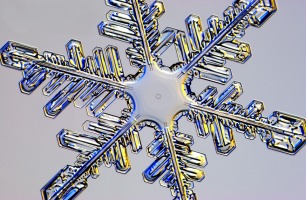 |
Including both Oxides and Hydroxides |
The Oxide Class of minerals is a rather diverse class. It includes minerals that are quite hard (corundum) and some that are quite soft such as psilomelane. It has metallic minerals such as hematite and gemstones such as corundum, chrysoberyl and spinel.
Many oxides are black but others can be very colorful. The large diversity of oxides can be partially attributed to the extreme abundance of oxygen in the Earth's crust. Oxygen comprises over 45% of the Earth's crust by weight. Most of this is locked up in more complex minerals based on chemical complex anions such as CO3, BO3, SO4, NO3, SiO4, PO4 and others. But great opportunities exist for single oxygen ions to combine with various elements in many different ways.
In a strict sense, minerals that belong to the more complex mineral classes such as the silicates are really oxides. But this would be cumbersome for mineralogists to be able to deal with only the four different classes of the elements class, the halides class, the sulfides class and finally the extremely large oxides class with all of its many subclasses and over 90% of all known minerals. By convention therefore, the oxides are limited to non complex minerals containing oxygen or hydroxide. Oxides also contain mostly ionic bonds and this helps distinguish members from the more complex mineral classes whose bonds are typically more covalent in nature. Quartz, SiO2, would be considered an oxide, and still is in some mineral guides and texts, except for its covalent silicon oxygen bonds and its structural similarity to the other Tectosilicates.
Hydrogen in the positive one (+1) state is really only a single proton and is so small that when it combines with oxygen it disappears into the oxygen and the resulting OH group is almost the same size as a single oxygen ion with a negative two (-2) charge. Hence the OH group can fit into many crystal sites that oxygen would otherwise occupy, but with a charge of only negative one (-1). The crystal would then need to be balanced by additional negative charges or fewer positive charges.
- Aeschynite (Rare Earth Yttrium Titanium Niobium Oxide Hydroxide)
- Anatase (Titanium Oxide)
- Becquerelite (Hydrated Calcium Uranyl Oxide Hydroxide)
- Bindheimite (Lead Antimony Oxide Hydroxide)
- Bixbyite (Manganese Iron Oxide)
- Brannerite (Uranium Calcium Titanium Iron Oxide)
- Brookite (Titanium Oxide)
- Chrysoberyl (Beryllium Aluminum Oxide)
- Columbite (Iron Manganese Niobium Tantalum Oxide)
- Corundum (Aluminum Oxide)
- Cuprite (Copper Oxide)
- Euxenite (Rare Earth Yttrium Niobium Tantalum Titanium Oxide)
Fergusonite (Rare Earth Iron Titanium Oxide)- Hausmannite (Manganese Oxide)
- Hematite (Iron Oxide)
- Ice (Hydrogen Oxide)
- Ilmenite (Iron Titanium Oxide)
- Perovskite (Calcium Titanium Oxide)
- Periclase (Magnesium Oxide)
Polycrase (Rare Earth Yttrium Titanium Niobium Tantalum Oxide)- Pseudobrookite (Iron Titanium Oxide)
- The Pyrochlore Group
- Betafite (Rare Earths Calcium Sodium Uranium Titanium Niobium Tantalum Oxide Hydroxide)
- Microlite (Calcium Sodium Tantalum Oxide Hydroxide Fluoride)
- Pyrochlore (Sodium Calcium Niobium Oxide Hydroxide Fluoride)
- Ramsdellite (Manganese Oxide)
- Romanechite (Hydrated Barium Manganese Oxide)
- The Rutile Group:
- Cassiterite (Tin Oxide)
- Plattnerite (Lead Oxide)
- Pyrolusite (Manganese Oxide)
- Rutile (Titanium Oxide)
- Stishovite (Silicon Oxide)
- Samarskite-(Y) (Rare Earth Yttrium Iron Titanium Oxide)
- Senarmontite (Antimony Oxide)
- The Spinel Group:
- Chromite (Iron Chromium Oxide)
- Franklinite (Zinc Manganese Iron Oxide)
- Gahnite (Zinc Aluminum Oxide)
- Magnesiochromite (Magnesium Chromium Oxide)
- Magnetite (Iron Oxide)
- Spinel (Magnesium Aluminum Oxide)
- Taaffeite (Beryllium Magnesium Aluminum Oxide)
- Tantalite (Iron Manganese Tantalum Niobium Oxide)
Tapiolite (Iron Manganese Tantalum Niobium Oxide)- Uraninite (Uranium Oxide)
- Valentinite (Antimony Oxide)
- Zincite (Zinc Manganese Oxide)
- Brucite (Magnesium Hydroxide)
- Gibbsite (Aluminum Hydroxide)
- Goethite (Iron Oxide Hydroxide)
- Limonite (Hydrated Iron Oxide Hydroxide)
- Manganite (Manganese Oxide Hydroxide)
- Psilomelane (Barium Manganese Oxide Hydroxide)
Romeite (Calcium Sodium Iron Manganese Antimony Titanium Oxide Hydroxide)Stetefeldtite (Silver Antimony Oxide Hydroxide)- Stibiconite (Antimony Oxide Hydroxide)





